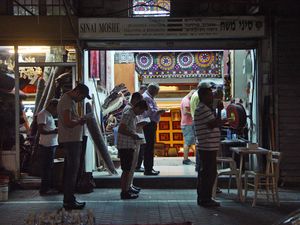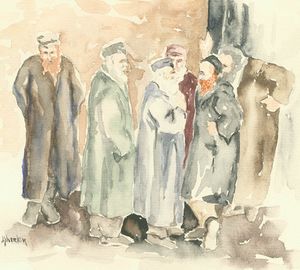منيان
| نصوص الهالاخاه المتعلقة بهذا المقال | |
|---|---|
| التوراة: | Leviticus 22:32 |
| المشناه: | Megillah 4:3 |
| التلمود البابلي: | Megillah 23b; Sanhedrin 74b |
| تلمود القدس: | Megillah 4:4 |
| مشناه توراة: | Hilchot Tefillah 8:1 |
| شولخان عروخ: | Orach Chayim 55 |
| جزء من سلسلة مقالات عن |
| اليهود و اليهودية |
|---|
  |
| من هو اليهودي؟ • أصل الكلمة • الثقافة |
في اليهودية، منيان (بالعبرية: מִנְיָן[minˈjan] حرفياً الاسم عدد؛ ويُجمع מִניָנִים منيانيم؛ إنگليزية: minyan) هو نـِصاب عشرة بالغين يهود، مطلوب لبعض المناسك الدينية. In more traditional streams of Judaism only men may constitute a minyan; in more modern streams women are also counted.[1][2]
The most common activity requiring a minyan is public prayer. Accordingly, the term minyan in contemporary Judaism has taken on the secondary meaning of referring to a prayer service.
المصادر
The source for the requirement of minyan is recorded in the Talmud. The word minyan itself comes from the Hebrew root [maneh] Error: {{Lang}}: text has italic markup (help) מנה meaning to count or to number. The word is related to the Aramaic word mene, numbered, appearing in the writing on the wall in Daniel 5:25.
التلمود البابلي
The Babylonian Talmud (Megillah 23b) derives the requirement of a minyan of ten shomer Shabbat for Kiddush Hashem[3] and Devarim she-Bikdusha, "matters of sanctity", by combining three scriptural verses using the rule of gezerah shavah:
The word "midst" in the verse:
- "And I shall be sanctified in the midst of the children of Israel" (Leviticus 22:32)
also appears in the verse:
- "Separate yourselves from the midst of the congregation" (Numbers 16:21)
The term "congregation" is also used in another verse that describes the ten spies who brought back a negative report of the Land of Israel:
- "How long shall I bear with this evil congregation which murmur against me?" (Numbers 14:27)
From this combination, the Talmud concludes that "sanctification" should occur in the "midst" of a "congregation" of ten.
التلمود المقدسي
The Jerusalem Talmud (Megillah 4:4) offers two sources for the requirement, also using a gezerah shavah:
The word "congregation" in the verse:
- "Speak to all the congregation of the children of Israel, and say to them: You shall be holy" (Leviticus 19:2)
is also used in another verse:
- "How long shall I bear with this evil congregation which murmur against me?" (Numbers 14:27)
Since the term "congregation" in the later verse refers to the ten spies, so too in the former verse: "You shall be holy" refers to a "congregation" of ten.
The second source is based on the term "children of Israel" which appears in the following two verses:
- "And I shall be sanctified in the midst of the children of Israel" (Leviticus 22:32)
- " And the children of Israel came to buy among those that came" (Genesis 42:5)
Just as the "children of Israel" in the later verse refers to the ten sons of Jacob who descended to Egypt to obtain food during the famine, so too the former verse refers to sanctification among the “children of Israel” in the presence of ten.
شعائر تتطلب منيان
Some rituals require a minyan; the presence of a rabbi (a teacher, not a priest) is not essential—it is said that "nine rabbis do not constitute a minyan, but ten cobblers can".[4]
الصلاة بـمنيان

انظر أيضاً
- Jewish services
- Torah reading
- Amidah
- Kaddish
- Birkat HaMazon
- Megillah
- Partnership minyan
- Tzadikim Nistarim
للاستزادة
- Adler, Rachel. "Innovation and authority : a feminist reading of the "women’s minyan" responsum" In Gender Issues in Jewish Law (2001) 3–32
- Broyde, Michael J.; Wolowelsky, Joel B. "Further on women as prayer leaders and their role in communal prayer; an exchange." Judaism. 42,4 (1993) 387–395.
- Feinstein, Moses. "Splitting the worshipers into two minyanim for the sake of two mourners." (Heb.) Iggrot Moshe, Noble Press Book Corp. Brooklyn, New York (1982); Yoreh Deah vol. 4, ch. 61:4.
- Feinstein, Moses. "Including one who dwells in the Land of Israel for a minyan on second day yom-tov." (Heb.) Iggrot Moshe, Noble Press Book Corp. Brooklyn, New York (1982); Orach Chayim vol. 4, ch. 106, pg. 196–199.
- Feinstein, Moses. "Including a person who is praying a different prayer." (Heb.) Iggrot Moshe, Noble Press Book Corp. Brooklyn, New York (1982); Orach Chayim vol. 4, ch. 20, pg. 31.
- Feinstein, Moses. "Including a minor in extraneous circumstances." (Heb.) Iggrot Moshe, Noble Press Book Corp. Brooklyn, New York (1982); Orach Chayim vol. 2, ch. 18, pg. 188–189.
- Feinstein, Moses. "Forming a minyan of minors for the purpose of religious instruction." (Heb.) Iggrot Moshe, Noble Press Book Corp. Brooklyn, New York (1982); Orach Chayim vol. 2 ch. 98, pg. 290.
- Feinstein, Moses. "Is it sufficient for the minyan to contain a majority of those who have not already prayed?" (Heb.) Iggrot Moshe, Noble Press Book Corp. Brooklyn, New York (1982); Orach Chayim vol. 1, ch. 28–30, pg. 72–76.
- Feinstein, Moses. "Including one who profanes the Sabbath." (Heb.) Iggrot Moshe, Noble Press Book Corp. Brooklyn, New York (1982); Orach Chayim vol. 1, ch. 23, pg. 66–67 & Orach Chayim vol. 1, ch. 19, pg. 189.
- Feinstein, Moses. "Is praying with a minyan obligatory or just preferential?" (Heb.) Iggrot Moshe, Noble Press Book Corp. Brooklyn, New York (1982); Orach Chayim vol. 1, ch. 31, pg. 77; Orach Chayim vol. 2, ch. 27, pg. 200–202; Orach Chayim vol. 3, ch. 7, pg. 305 & Orach Chayim vol. 4, ch. 2, pg. 27.
- Hauptman, Judith. "Some thoughts on the nature of halakhic adjudication; women and "minyan"." in Judaism 42,4 (1993) 396–413.
- Oppenheimer, Steven. "The breakaway minyan" in Journal of Halacha and Contemporary Society 46 (2003) 41–59
- Safrai, Chana. "The "minyan" : gender and democracy" (Heb.) in Men and Women; Gender, Judaism and Democracy. Ed.: Rachel Elior. Jerusalem: Van Leer Jerusalem Institute; Urim Publications, 2004
- Schachter, Zvi. (Essay on women’s minyan) "Bet Yitzhak" 17 (1985).
- Sternbuch, Moishe. "Is it better to include someone who profanes the Sabbath or dissolve the minyan?" (Heb.) Teshuvos VeHanhagos, Frank Publishing, Jerusalem (1997); vol. 1, ch. 469.
- Sternbuch, Moishe. "Counting the Omer with a minyan" (Heb.) Teshuvos VeHanhagos, Frank Publishing, Jerusalem (1997); vol. 1, ch. 310.
- Sternbuch, Moishe. "Including a person whose hearing is assisted with a hearing aid" (Heb.) Teshuvos VeHanhagos, Frank Publishing, Jerusalem (1997); vol. 1, ch. 101.
- Sternbuch, Moishe. "Including someone who lives with a non-Jewish lady" (Heb.) Teshuvos VeHanhagos, Frank Publishing, Jerusalem (1997); vol. 1, ch. 113.
- Sternbuch, Moishe. "Including someone who has not yet finished the silent prayer" (Heb.) Teshuvos VeHanhagos, Frank Publishing, Jerusalem (1997); vol. 1, ch. 104.
- Sternbuch, Moishe. "Including worshipers who are praying outside the synagogue" (Heb.) Teshuvos VeHanhagos, Frank Publishing, Jerusalem (1997); vol. 1, ch. 163.
- Sternbuch, Moishe. "Sanctifying the new moon with a minyan" (Heb.) Teshuvos VeHanhagos, Frank Publishing, Jerusalem (1997); vol. 1, ch. 205.
- Sternbuch, Moishe. "Reciting Birkat ha-Gomel in the presence of ten people" (Heb.) Teshuvos VeHanhagos, Frank Publishing, Jerusalem (1997); vol. 2, ch. 143.
- Sternbuch, Moishe. "Going on holiday to place where there is no minyan" (Heb.) Teshuvos VeHanhagos, Frank Publishing, Jerusalem (1997); vol. 2, ch. 63.
- Sternbuch, Moishe. "Leaving an exact minyan during prayer" (Heb.) Teshuvos VeHanhagos, Frank Publishing, Jerusalem (1997); vol. 2, ch. 62.
- Sternbuch, Moishe. "Including an Israeli for the Reading of the Law on second day yom-tov of the diaspora" (Heb.) Teshuvos VeHanhagos, Frank Publishing, Jerusalem (1997); vol. 2, ch. 89.
- Sternbuch, Moishe. "Including a despondent person with the worry that he may not respond" (Heb.) Teshuvos VeHanhagos, Frank Publishing, Jerusalem (1997); vol. 2, ch. 61.
- Sternbuch, Moishe. "Annulment of vows on New Year’s eve with a minyan" (Heb.) Teshuvos VeHanhagos, Frank Publishing, Jerusalem (1997); vol. 3, ch. 161.
- Weiss, Yitzchok Yaakov. "In an unenclosed area, how close together must people be to be considered part of the minyan?" (Heb.) Minchat Yitzchak, Minchat Yitzchak Publishing, Jerusalem (1991); vol. 2, ch. 44.
- Weiss, Yitzchok Yaakov. "Can one person make up two separate minyanim simultaneously?" (Heb.) Minchat Yitzchak, Minchat Yitzchak Publishing, Jerusalem (1991); vol. 2, ch. 45.
- Weiss, Yitzchok Yaakov. "Including a person who desecrates the Sabbath." (Heb.) Minchat Yitzchak, Minchat Yitzchak Publishing, Jerusalem (1991); vol. 3, ch. 26:4; vol. 6, ch. 9.
- Weiss, Yitzchok Yaakov. "Including a person who married out" (Heb.) Minchat Yitzchak, Minchat Yitzchak Publishing, Jerusalem (1991); vol. 3, ch. 65.
- Weiss, Yitzchok Yaakov. "Can people in a corridor be included in a minyan?" (Heb.) Minchat Yitzchak, Minchat Yitzchak Publishing, Jerusalem (1991); vol. 4, ch. 9.
- Weiss, Yitzchok Yaakov. "Regarding a small congregation who need to hire out people to make up the minyan" (Heb.) Minchat Yitzchak, Minchat Yitzchak Publishing, Jerusalem (1991); vol. 9, ch. 1, pg. 17–18.
- Weiss, Yitzchok Yaakov. "Can women make up their own minyan" (Heb.) Minchat Yitzchak, Minchat Yitzchak Publishing, Jerusalem (1991); vol. 9, ch. 11a, pg. 17.
- Wolowelsky, Joel B. (1992). "Women's Participation in Sheva Berakhot". Modern Judaism. 12 (2): 157. doi:10.1093/mj/12.2.157.
- Zuckerman, P. (1997). "Gender Regulation as a Source of Religious Schism". Sociology of Religion. 58 (4): 353–373. doi:10.2307/3711921. JSTOR 3711921.
- Frimer, Aryeh. “Women and Minyan”.[5] Tradition 23:4, (1988) 54–77.
الهامش
- ^ Fine, Rabbi David J. (12 June 2012). "Women and the Minyan" (PDF). Committee on Jewish Law and Standards of the Rabbinical Assembly (in English and Hebrew). New York, NY: Rabbinical Assembly. Retrieved 23 May 2011.
{{cite web}}: CS1 maint: unrecognized language (link) - ^ Golinkin, Rabbi David. "Women in the Minyan and as Shelihot Tzibbur". Va'ad Halakhah – English Summaries. Jerusalem, Israel: Schechter Institute of Jewish Studies. Retrieved 23 May 2011.
- ^ Sanhedrin 74b
- ^ Temple Israel Chrnicle, January 2009, p3
- ^ http://www.daat.ac.il/daat/english/tfila/frimer2-1.htm
وصلات خارجية
- Minyan – Jewish Encyclopedia article.
- The Minyan Project by Mechon Hadar
- GoDaven.com Find an Orthodox Minyan anywhere in the world.
- What is a Minyan? on Ask Moses
- What's the Truth about... Davening with a Minyan?PDF (92.9 KiB) (OU.org)
- Minyan in the Jewish Knowledge Base on Chabad.org
- Frimer, A., Women and Minyan. Tradition 23:4, pp. 54–77 (1988) (Modern Orthodox view of women in minyan for various purposes)

